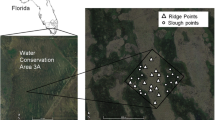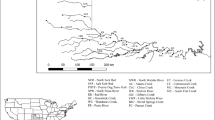Abstract
Many species traverse multiple habitats across ecosystems to complete their life histories. Degradation of critical, life stage-specific habitats can therefore lead to population bottlenecks and demographic deficits in sub-populations. The riparian zone of waterways is one of the most impacted areas of the coastal zone because of urbanisation, deforestation, farming and livestock grazing. We hypothesised that sink populations can result from alterations of habitats critical to the early life stages of diadromous fish that use this zone, and tested this with field-based sampling and experiments. We found that for Galaxias maculatus, one of the most widely distributed fishes of the southern hemisphere, obligate riparian spawning habitat was very limited and highly vulnerable to disturbance across 14 rivers in New Zealand. Eggs were laid only during spring tides, in the highest tidally influenced vegetation of waterways. Egg survival increased to >90% when laid in three riparian plant species and where stem densities were great enough to prevent desiccation, compared to no survival where vegetation was comprised of other species or was less dense. Experimental exclusion of livestock, one of the major sources of riparian degradation in rural waterways, resulted in quick regeneration, a tenfold increase in egg laying by fish and a threefold increase in survival, compared to adjacent controls. Overall, there was an inverse relationship between river size and egg production. Some of the largest rivers had little or no spawning habitat and very little egg production, effectively becoming sink populations despite supporting large adult populations, whereas some of the smallest pristine streams produced millions of eggs. We demonstrate that even a wide-ranging species with many robust adult populations can be compromised if a stage-specific habitat required to complete a life history is degraded by localised or more diffuse impacts.







Similar content being viewed by others
References
Allibone R, Boubée J, West D (1999) The ones that got away: determining whitebait movements and rates of escape. Water Atmos 7:11–13
Anon (2004) Water bodies of national importance: potential water bodies of national importance for recreational value. New Zealand Ministry for the Environment, Wellington
Battin J (2004) When good animals love bad habitats: ecological traps and the conservation of animal populations. Conserv Biol 18:1482–1491. doi:10.1111/j.1523-1739.2004.00417.x
Belsky AJ, Matzke A, Uselman S (1999) Survey of livestock influences on stream and riparian ecosystems in the western United States. J Soil Water Conserv 54:419–431
Benzie V (1968) Some ecological aspects of the spawning behaviour of the common whitebait Galaxias maculatus attenuatus (Jenyns). Proc NZ Ecol Soc 15:31–39
Bush J (2008) West Coast whitebaiters association submission on the proposed Mokihinui River hydro power scheme. West Coast Regional Council, Greymouth
Chapman A, Morgan DL, Beatty SJ, Gill HS (2006) Variation in life history of land-locked lacustrine and riverine populations of Galaxias maculatus (Jenyns 1842) in Western Australia. Environ Biol Fish 77:21–37. doi:10.1007/s10641-006-9051-2
Delibes M, Ferreras P, Gaona P (2001a) Attractive sinks, or how individual behavioural decisions determine source-sink dynamics. Ecol Lett 4:401–403. doi:10.1046/j.1461-0248.2001.00254.x
Delibes M, Gaona P, Ferreras P (2001b) Effects of an attractive sink leading into maladaptive habitat selection. Am Nat 158:277–285
DeMartini EE (1999) Intertidal spawning. In: Horn MH, Martin KLM, Chotkowski MA (eds) Intertidal fishes: life in two worlds. Academic, San Diego, pp 143–164
Dias PC (1996) Sources and sinks in population biology. Trends Ecol Evol 11:326–330. doi:10.1016/0169-5347(96)10037-9
Doak DF (1995) Source-sink models and the problem of habitat degradation: general models and applications to the Yellowstone grizzly. Conserv Biol 9:1370–1379
Geiger R, Aron RH, Todhunter P (2003) The climate near the ground. Rowman & Littlefield, Lanham
Gilroy JJ, Sutherland WJ (2007) Beyond ecological traps: perceptual errors and undervalued resources. Trends Ecol Evol 22:351–356. doi:10.1016/j.tree.2007.03.014
Gisbert E, López MA (2008) Impact of glass eel fishery on by-catch fish species: a quantitative assessment. Hydrobiologia 602:87–98. doi:10.1007/s10750-008-9284-5
Grimes CB, Kingsford MJ (1996) How do riverine plumes of different sizes influence fish larvae: do they enhance recruitment? Mar Freshw Res 47:191–208
Gundersen G, Johannesen E, Andreassen HP, Ims RA (2001) Source-sink dynamics: how sinks affect demography of sources. Ecol Lett 4:14–21. doi:10.1046/j.1461-0248.2001.00182.x
Hickford MJH, Schiel DR (2003) Comparative dispersal of larvae from demersal versus pelagic spawning fishes. Mar Ecol Prog Ser 252:255–271. doi:10.3354/meps252255
Hickford MJH, Cagnon M, Schiel DR (2010) Predation, vegetation and habitat-specific survival of terrestrial eggs of a diadromous fish, Galaxias maculatus (Jenyns, 1842). J Exp Mar Biol Ecol 385:66–72. doi:10.1016/j.jembe.2010.01.010
Johnson DM (2004) Source-sink dynamics in a temporally, heterogeneous environment. Ecology 85:2037–2045
Kappel CV (2005) Losing pieces of the puzzle: threats to marine, estuarine, and diadromous species. Front Ecol Environ 3:275–282
Kauffman JB, Krueger WC (1984) Livestock impacts on riparian ecosystems and streamside management implications—a review. J Range Manage 37:430–438
Kawecki TJ (2008) Adaptation to marginal habitats. Annu Rev Ecol Evol S 39:321–342. doi:10.1146/annurev.ecolsys.38.091206.095622
Kawecki TJ, Holt RD (2002) Evolutionary consequences of asymmetric dispersal rates. Am Nat 160:333–347
Kennish MJ (2002) Environmental threats and environmental future of estuaries. Environ Conserv 29:78–107. doi:10.1017/s0376892902000061
Kinlan BP, Gaines SD, Lester SE (2005) Propagule dispersal and the scales of marine community process. Divers Distrib 11:139–148. doi:10.1111/j.1366-9516.2005.00158.x
Lucas MC, Bubb DH, Jang MH, Ha K, Masters JEG (2009) Availability of and access to critical habitats in regulated rivers: effects of low-head barriers on threatened lampreys. Freshw Biol 54:621–634. doi:10.1111/j.1365-2427.2008.02136.x
Martin KLM, Van Winkle RC, Drais JE, Lakisic H (2004) Beach-spawning fishes, terrestrial eggs, and air breathing. Physiol Biochem Zool 77:750–759
McDowall RM (1965) The composition of the New Zealand whitebait catch, 1964. NZ J Sci 8:285–300
McDowall RM (1968) Galaxias maculatus (Jenyns), the New Zealand Whitebait. NZ Mar Dept Fish Res Bull 2:1–83
McDowall RM (1993) Implications of diadromy for the structuring and modelling of riverine fish communities in New Zealand. NZ J Mar Freshw Res 27:453–462
McDowall RM, Charteris SC (2006) The possible adaptive advantages of terrestrial egg deposition in some fluvial diadromous galaxiid fishes (Teleostei : Galaxiidae). Fish Fish 7:153–164. doi:10.1111/j.1467-2979.2006.00217.x
McDowall RM, Eldon GA (1980) The ecology of whitebait migrations (Galaxiidae: Galaxias spp.). Fish Res Bull NZ Min Agric Fish 20:1–172
McDowall RM, Mitchell CP, Brothers EB (1994) Age at migration from the sea of juvenile Galaxias in New Zealand (Pisces, Galaxiidae). Bull Mar Sci 54:385–402
McKeown BA (1984) Fish migration. Croom Helm, London
Metcalfe JD, Arnold GP, McDowall RM (2002) Migration. In: Hart PJB, Reynolds JD (eds) Fish biology. Handbook of fish biology and fisheries, vol 1. Blackwell, Oxford, pp 175–199
Nehlsen W, Williams JE, Lichatowich JA (1991) Pacific salmon at the crossroads: stocks at risk from California, Oregon, Idaho, and Washington. Fisheries 16:4–21
Pollard DA (1971) The biology of a landlocked form of normally catadromous Salmoniform fish Galaxias maculatus (Jenyns) I. Life-cycle and origin. Aust J Mar Freshw Res 22:91–123
Pulliam HR (1988) Sources, sinks, and population regulation. Am Nat 132:652–661
Pulliam HR (1996) Sources and sinks: empirical evidence and population consequences. In: Rhodes OE Jr, Chesser RK, Smith MH (eds) Population dynamics in ecological space and time. University of Chicago Press, Chicago, pp 45–69
Remeš V (2000) How can maladaptive habitat choice generate source-sink population dynamics? Oikos 91:579–582
Richardson J, Jowett I, Smith J, Christiansen R, Christiansen B (2000) Inanga comings and goings—what happens to the whitebait that do get away? Water Atmos 8:6–7
Robinson SK, Thompson FR, Donovan TM, Whitehead DR, Faaborg J (1995) Regional forest fragmentation and the nesting success of migratory birds. Science 267:1987–1990. doi:10.1126/science.267.5206.1987
Romanelli M, Colloca F, Giovanardi O (2002) Growth and mortality of exploited Sardina pilchardus (Walbaum) larvae along the western coast of Italy. Fish Res 55:205–218. doi:10.1016/S0165-7836(01)00286-7
Rowe DK, Saxton BA, Stancliff AG (1992) Species composition of whitebait (Galaxiidae) fisheries in 12 Bay of Plenty rivers, New Zealand: evidence for river mouth selection by juvenile Galaxias brevipinnis (Günther). NZ J Mar Freshw Res 26:219–228
Schtickzelle N, Quinn TP (2007) A metapopulation perspective for salmon and other anadromous fish. Fish Fish 8:297–314. doi:10.1111/j.1467-2979.2007.00256.x
Sokal RR, Rohlf FJ (1981) Biometry, 2nd edn. Freeman, New York
Taylor MJ (2002) The national inanga spawning database: trends and implications for spawning site management. Sci Conserv 188:1–37
Underwood AJ (1997) Experiments in ecology: their logical design and interpretation using analysis of variance. Cambridge University Press, New York
Waters JM, Dijkstra LH, Wallis GP (2000) Biogeography of a southern hemisphere freshwater fish: how important is marine dispersal? Mol Ecol 9:1815–1821. doi:10.1046/j.1365-294x.2000.01082.x
Wells BK, Grimes CB, Sneva JG, McPherson S, Waldvogel JB (2008) Relationships between oceanic conditions and growth of Chinook salmon (Oncorhynchus tshawytscha) from California, Washington, and Alaska, USA. Fish Oceanogr 17:101–125. doi:10.1111/j.1365-2419.2008.00467.x
Williamson RB, Smith RK, Quinn JM (1992) Effects of riparian grazing and channelisation on streams in Southland, New Zealand 1. Channel form and stability. NZ J Mar Freshw Res 26:241–258
Acknowledgments
We thank K. O’Connell, D. Taylor, K. Seaward, M. Møhl, S. Lilley and the Marine Ecology Research Group for assistance, Canterbury University for logistic support, and R. Warner for reviewing the manuscript. Thanks to R.M. McDowall and an anonymous reviewer for helpful comments. Thanks to the New Zealand Foundation for Research, Science and Technology (UOCX0502) and the A.W. Mellon Foundation of New York for funding.
Author information
Authors and Affiliations
Corresponding author
Additional information
Communicated by Øyvind Fiksen.
Electronic supplementary material
Below is the link to the electronic supplementary material.
Rights and permissions
About this article
Cite this article
Hickford, M.J.H., Schiel, D.R. Population sinks resulting from degraded habitats of an obligate life-history pathway. Oecologia 166, 131–140 (2011). https://doi.org/10.1007/s00442-010-1834-7
Received:
Accepted:
Published:
Issue Date:
DOI: https://doi.org/10.1007/s00442-010-1834-7




